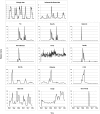Correlation between national influenza surveillance data and google trends in South Korea
- PMID: 24339927
- PMCID: PMC3855287
- DOI: 10.1371/journal.pone.0081422
Correlation between national influenza surveillance data and google trends in South Korea
Abstract
Background: In South Korea, there is currently no syndromic surveillance system using internet search data, including Google Flu Trends. The purpose of this study was to investigate the correlation between national influenza surveillance data and Google Trends in South Korea.
Methods: Our study was based on a publicly available search engine database, Google Trends, using 12 influenza-related queries, from September 9, 2007 to September 8, 2012. National surveillance data were obtained from the Korea Centers for Disease Control and Prevention (KCDC) influenza-like illness (ILI) and virologic surveillance system. Pearson's correlation coefficients were calculated to compare the national surveillance and the Google Trends data for the overall period and for 5 influenza seasons.
Results: The correlation coefficient between the KCDC ILI and virologic surveillance data was 0.72 (p<0.05). The highest correlation was between the Google Trends query of H1N1 and the ILI data, with a correlation coefficient of 0.53 (p<0.05), for the overall study period. When compared with the KCDC virologic data, the Google Trends query of bird flu had the highest correlation with a correlation coefficient of 0.93 (p<0.05) in the 2010-11 season. The following queries showed a statistically significant correlation coefficient compared with ILI data for three consecutive seasons: Tamiflu (r = 0.59, 0.86, 0.90, p<0.05), new flu (r = 0.64, 0.43, 0.70, p<0.05) and flu (r = 0.68, 0.43, 0.77, p<0.05).
Conclusions: In our study, we found that the Google Trends for certain queries using the survey on influenza correlated with national surveillance data in South Korea. The results of this study showed that Google Trends in the Korean language can be used as complementary data for influenza surveillance but was insufficient for the use of predictive models, such as Google Flu Trends.
Conflict of interest statement
Figures


References
-
- Varney SM, Hirshon JM (2006) Update on public health surveillance in emergency departments. Emerg Med Clin North Am 24: 1035–1052. - PubMed
-
- Henning KJ (2004) What is syndromic surveillance? MMWR Morb Mortal Wkly Rep 53 Suppl: 5–11 - PubMed
-
- Frenk J, Gomez-Dantes O (2002) Globalization And The Challenges To Health Systems. Health Affairs 21: 160–165. - PubMed
-
- Irvin CB, Nouhan PP, Rice K (2003) Syndromic analysis of computerized emergency department patients' chief complaints: An opportunity for bioterrorism and influenza surveillance. Annals of Emergency Medicine 41: 447–452. - PubMed
-
- Hirshon JM (2000) The rationale for developing public health surveillance systems based on emergency department data. Acad Emerg Med 7: 1428–1432. - PubMed
MeSH terms
LinkOut - more resources
Full Text Sources
Other Literature Sources
Medical

